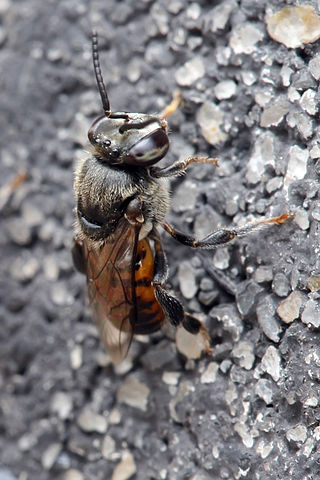
Stingless bees (SB), sometimes called stingless honey bees or simply meliponines, are a large group of bees (from about 462 to 552 described species), comprising the tribe Meliponini (or subtribe Meliponina according to other authors). They belong in the family Apidae (subfamily Apinae), and are closely related to common honey bees (HB, tribe Apini), orchid bees (tribe Euglossini), and bumblebees (tribe Bombini). These four bee tribes belong to the corbiculate bees monophyletic group. Meliponines have stingers, but they are highly reduced and cannot be used for defense, though these bees exhibit other defensive behaviors and mechanisms. Meliponines are not the only type of bee incapable of stinging: all male bees and many female bees of several other families, such as Andrenidae and Megachilidae (tribe Dioxyini), also cannot sting.

The gyne is the primary reproductive female caste of social insects. Gynes are those destined to become queens, whereas female workers are typically barren and cannot become queens. Having a queen is what makes a "queenright" hive, nest, or colony of eusocial insects. A colony with multiple queens is said to be a polygyne form, whereas one with only one is a monogyne form.

Schwarziana quadripunctata is a small, stingless bee found in a stretch of the South American Amazon from Goiás, Brazil, through Paraguay, to Misiones, Argentina. This highly eusocial insect constructs earthen nests in the subterranean level of the subtropical environment, an unusual feature among other stingless bees. The species ranges in sizes from 6.0 to 7.5 millimetres and feeds on a diverse diet of flowering plants found abundantly on the forest floor, including guacatonga and the mistletoe species Struthanthus concinnus.
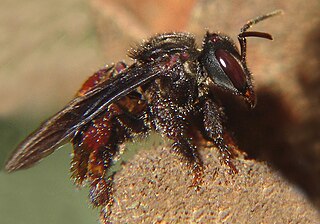
Trigona is one of the largest genera of stingless bees, comprising about 32 species, exclusively occurring in the New World, and formerly including many more subgenera than the present assemblage; many of these former subgenera have been elevated to generic status.

Frieseomelitta is a stingless bee (Meliponini) genus in the family Apidae. It currently contains about 16 described species:

Tetragonula carbonaria is a stingless bee, endemic to the north-east coast of Australia. Its common name is sugarbag bee. They are also occasionally referred to as bush bees. The bee is known to pollinate orchid species, such as Dendrobium lichenastrum, D. toressae, and D. speciosum. It has been identified as an insect that collects pollen from the cycad Cycas media. They are also known for their small body size, reduced wing venation, and highly developed social structure comparable to honey bees.

Trigona spinipes is a species of stingless bee. It occurs in Brazil, where it is called arapuá, aripuá, irapuá, japurá or abelha-cachorro ("dog-bee"). The species name means "spiny feet" in Latin. Trigona spinipes builds its nest on trees, out of mud, resin, wax, and assorted debris, including dung. Therefore, its honey is not fit for consumption, even though it is reputed to be of good quality by itself, and is used in folk medicine. Colonies may have from 5,000 to over 100,000 workers.

Tetragonisca angustula is a small eusocial stingless bee found in México, Central and South America. It is known by a variety of names in different regions. A subspecies, Tetragonisca angustula fiebrigi, occupies different areas in South America and has a slightly different coloration.

Melipona bicolorLepeletier, 1836, commonly known as Guaraipo or Guarupu, is a eusocial bee found primarily in South America. It is an inhabitant of the Araucaria Forest and the Atlantic Rainforest, and is most commonly found from South to East Brazil, Bolivia, Argentina, and Paraguay. It prefers to nest close to the soil, in hollowed trunks or roots of trees. M. bicolor is a member of the tribe Meliponini, and is therefore a stingless bee. This species is unique among the stingless bees species because it is polygynous, which is rare for eusocial bees.

Plebeia remota is a species of stingless bee that is in the family Apidae and tribe Meliponini. Bees of the species are normally found in a few states in southern Brazil and their nests can be found in tree cavities. Depending on the region, P. remota may have a different morphology and exhibit different behaviors. The bee's diet consists of nectar and pollen that are collected intensely from a few sources. Researchers have conducted a multitude of studies analyzing the changes that occur in the colony during reproductive diapause and what happens during the provisioning and oviposition process or POP.

Melipona subnitida is a neotropical bee species in the Apidae family found in the dry areas of Northeastern Brazil. This species of stingless bees practices single mating, monogynous habits.
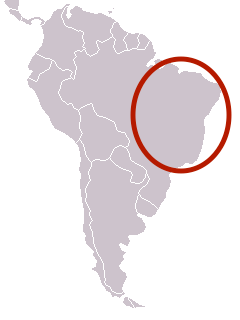
Nannotrigona testaceicornis is a eusocial stingless bee species of the order Hymenoptera and the genus Nannotrigona. Its local common name is abelhas iraí. This species has a large geographic distribution and occupies different biomes, including urban areas, around Neotropical America. The bees of this species nest in trees or artificial cavities because of this broad distribution. N. testaceicornis is important for agriculture because it will pollinate a vast number of plant species year round.
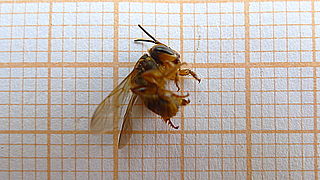
Scaptotrigona postica is a species of stingless bee that lives mainly in Brazil. It is a eusocial bee in the tribe Meliponini. S. postica is one of 25 species in the genus Scaptotrigona and is a critical pollinator of the tropical rain forests of Brazil. They construct their nests in hollowed sections of tree trunks, allowing for effective guarding at the nest entrance. This species shows colony structure similar to most members of the Meliponini tribe with three roles within the colony: queen, worker, and male. S. postica individuals have different forms of communication from cuticular hydrocarbons to pheromones and scent trails. Communication is especially useful during worker foraging for nectar and pollen through the Brazilian tropical rain forests. S. postica is a very important pollinator of the Brazilian tropical rain forests and is widely appreciated for its honey. Stingless bees account for approximately 30% of all pollination of the Brazilian Caatinga and Pantanal ecosystems and up to 90% of the pollination for many species of the Brazilian Atlantic Forest and the Amazon.

Paratrigona subnuda, commonly known as the jataí-da-terra, is a species of eusocial stingless bee in the family Apidae and tribe Meliponini. These social bees are prevalent in Neotropical moist forests, including Brazilian Atlantic and other South American forests. They inhabit spherical nests in moist underground environments with their forest habitats. Within their Neotropical habitats the P. subnuda is considered to be a very successful and common species of bee. P. subnuda’s main source of food is pollen and nectar from a large variety of native Mesoamerican tropical plants. They have been extensively studied due to social conflicts arising from single mate behaviors and particular virgin behaviors. P. subnuda also exhibits the particular daily behavior in which they open the nest entrance at dawn and close the entrance at dusk when all their activities are done.

Melipona quadrifasciata is a species of eusocial, stingless bee of the order Hymenoptera. It is native to the southeastern coastal states of Brazil, where it is more commonly known as mandaçaia, which means "beautiful guard," as there is always a bee at the narrow entrance of the nest. M. quadrifasciata constructs mud hives in the hollows of trees to create thin passages that only allow one bee to pass at a time. Because they are stingless bees, M. quadrifasciata is often used as pollinators in greenhouses, outperforming honey bees in efficiency and leading to overall larger yields of fruits that were heavier, larger, and contained more seeds.
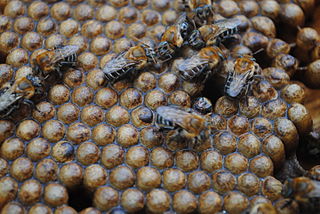
Melipona scutellaris is a eusocial stingless bee species of the order Hymenoptera and the genus Melipona. It is considered to be the reared Melipona species with the largest distribution in the North and Northeast regions of Brazil, with records from Rio Grande do Norte down to Bahia. Its common name, Uruçu, comes from the Tupi "eiru su", which in this indigenous language means "big bee". Their honey is highly desirable and the materials they create for nests have been proven to be a promising source of antibiofilm agents and to present selectivity against human cancer cell lines at low concentrations compared to normal cells.

Trigona fuscipennis is a stingless bee species that originates in Mexico but is also found in Central and South America. They are an advanced eusocial group of bees and play a key role as pollinators in wet rainforests. The species has many common names, including mapaitero, sanharó, abelha-brava, xnuk, k'uris-kab, enreda, corta-cabelo, currunchos, zagaño, and enredapelos.

Lestrimelitta limao is a neotropical eusocial bee species found in Brazil and Panama and is part of the Apidae family. It is a species of stingless bees that practices obligate nest robbing. They have never been spotted foraging from flowers, an observation that supports their raiding behavior. Because of their lack of hind corbiculae, they must raid to obtain enough protein in their diet in the form of pollen and nectar. Lestrimelitta limao secrete a lemon-scented alarm allomone, from which they receive their name, in order to conduct successful raids. L. limao are hypothesized to produce poisonous honey that is toxic if consumed by humans. Because robber bees are so rare and difficult to observe, there is a limited scope of information available.

Frieseomelitta varia, commonly known as the abelha marmelada-amarela, is a species of eusocial stingless bee in the family Apidae and tribe Meliponini. F. varia is native to Brazil.
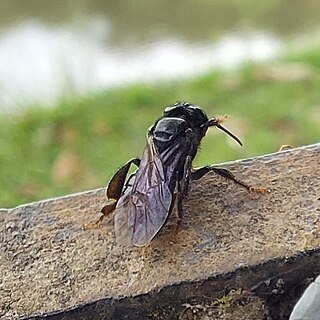
Partamona helleri, the Heller's stingless bee, is a species of stingless bee from Brazil. It is an aggressive species of bee, when threatened it coils around the victim's hair and fur, in addition to nibbling the skin with its mandibles.



















